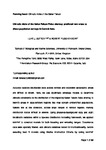Climatic niche of the Saker Falcon Falco cherrug: predicted new areas to direct population surveys in Central Asia
| dc.contributor.author | Sutton, L | |
| dc.contributor.author | Puschendorf, Robert | |
| dc.date.accessioned | 2018-12-12T14:53:25Z | |
| dc.date.issued | 2018-12-11 | |
| dc.identifier.issn | 0019-1019 | |
| dc.identifier.issn | 1474-919X | |
| dc.identifier.uri | http://hdl.handle.net/10026.1/13028 | |
| dc.description.abstract |
<jats:p>Accurate species distribution data across remote and extensive geographical areas are difficult to obtain. Here, we use bioclimatic envelope models to determine climatic constraints on the distribution of the migratory Saker Falcon <jats:italic>Falco cherrug</jats:italic> to identify areas in data‐deficient regions that may contain unidentified populations. Sakers live at low densities across large ranges in remote regions, making distribution status difficult to assess. Using presence‐background data and eight bioclimatic variables within a species distribution modelling framework, we applied MaxEnt to construct models for both breeding and wintering ranges. Occurrence data were spatially filtered and climatic variables tested for multicollinearity before selecting best fit models using the Akaike information criterion by tuning MaxEnt parameters. Model predictive performance tested using the continuous Boyce index (<jats:italic>B</jats:italic>) was high for both breeding (<jats:italic>B</jats:italic><jats:sub>TEST</jats:sub> = 0.921) and wintering models (<jats:italic>B</jats:italic><jats:sub>TEST</jats:sub> = 0.735), with low omission rates and minimal overfitting. The Saker climatic niche was defined by precipitation in the warmest quarter in the breeding range model, and mean temperature in the wettest quarter in the wintering range model. Our models accurately predicted areas of highest climate suitability and defined the climatic constraints on a wide‐ranging rare species, suggesting that climate is a key determinant of Saker distribution across macro‐scales. We recommend targeted population surveys for the Saker based on model predictions to areas of highest climatic suitability in key regions with distribution knowledge gaps, in particular the Qinghai‐Tibet plateau in western China. Further applications of our models could identify protected areas and reintroduction sites, inform development conflicts, and assess the impact of climate change on distributions.</jats:p> | |
| dc.format.extent | 27-41 | |
| dc.language | en | |
| dc.language.iso | en | |
| dc.publisher | Wiley | |
| dc.subject | bioclimatic envelope models | |
| dc.subject | biogeography | |
| dc.subject | conservation planning | |
| dc.subject | endangered raptors | |
| dc.subject | MaxEnt | |
| dc.subject | species distribution models | |
| dc.title | Climatic niche of the Saker Falcon Falco cherrug: predicted new areas to direct population surveys in Central Asia | |
| dc.type | journal-article | |
| dc.type | Journal Article | |
| plymouth.author-url | https://www.webofscience.com/api/gateway?GWVersion=2&SrcApp=PARTNER_APP&SrcAuth=LinksAMR&KeyUT=WOS:000569093100003&DestLinkType=FullRecord&DestApp=ALL_WOS&UsrCustomerID=11bb513d99f797142bcfeffcc58ea008 | |
| plymouth.issue | 1 | |
| plymouth.volume | 162 | |
| plymouth.publication-status | Published | |
| plymouth.journal | IBIS: The International Journal of Avian Science | |
| dc.identifier.doi | 10.1111/ibi.12700 | |
| plymouth.organisational-group | /Plymouth | |
| plymouth.organisational-group | /Plymouth/Faculty of Science and Engineering | |
| plymouth.organisational-group | /Plymouth/Faculty of Science and Engineering/School of Biological and Marine Sciences | |
| plymouth.organisational-group | /Plymouth/REF 2021 Researchers by UoA | |
| plymouth.organisational-group | /Plymouth/REF 2021 Researchers by UoA/UoA06 Agriculture, Veterinary and Food Science | |
| plymouth.organisational-group | /Plymouth/Users by role | |
| plymouth.organisational-group | /Plymouth/Users by role/Academics | |
| dcterms.dateAccepted | 2018-12-05 | |
| dc.rights.embargodate | 2019-12-11 | |
| dc.identifier.eissn | 1474-919X | |
| dc.rights.embargoperiod | Not known | |
| rioxxterms.versionofrecord | 10.1111/ibi.12700 | |
| rioxxterms.licenseref.uri | http://www.rioxx.net/licenses/all-rights-reserved | |
| rioxxterms.licenseref.startdate | 2018-12-11 | |
| rioxxterms.type | Journal Article/Review |


